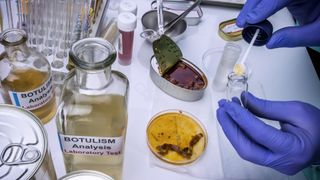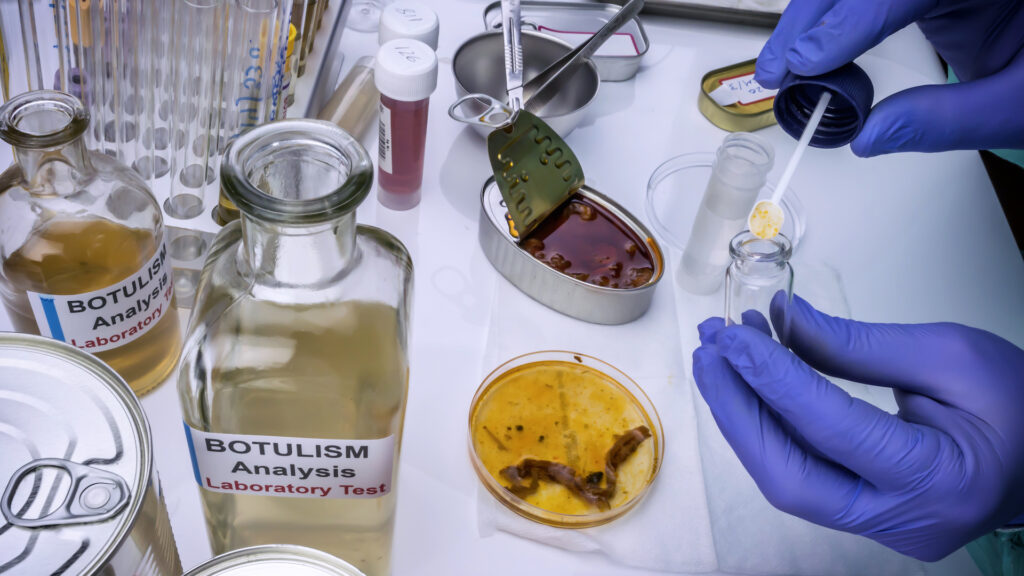
A researcher tests food for botulism.
(Image credit: DIGICOMPHOTO/SCIENCE PHOTO LIBRARY via Getty Images)
It’s easy to think of some pretty nasty substances. Botulinum toxin, a poison produced by Clostridium botulinum bacteria, is the most toxic naturally occurring substance on Earth, blocking nerve signals to muscles to cause death by paralysis. Similarly, the potent nerve agent VX, developed as a chemical weapon by the British military, also asphyxiates its victims by paralyzing the respiratory muscles. Chlorine trifluoride, an ultracorrosive colorless gas, is so reactive that it spontaneously explodes on contact with seemingly innocuous materials like water, sand and even the ashes of substances which have already burnt.
There are so many diabolical possibilities, but which chemical is the most dangerous?
It comes down to a combination of effect and exposure—how much makes a deadly dose and what exactly will it do to you? Nerve agents are widely considered the most toxic chemical weapons owing to their tiny toxic limits and devastatingly rapid impacts on the human body: Just 10 milligrams (that’s ten thousandths of a gram) of VX is enough to cause death within minutes. Yet just one person has been killed by the nerve agent over the last decade.
Meanwhile, more than 100,000 people are accidentally poisoned in the U.S. every year by common household chemicals such as bleach and disinfectant, even though these substances are slower-acting and far less toxic than VX. And some common chemicals can be fatal when combined. For instance, combining drain cleaner and bleach will release poisonous chlorine gas.
Those two examples highlight a key problem in ranking chemicals in order of danger: To evaluate danger, you need to know how likely you are to encounter a chemical.
Safety professionals define danger using a combination of two factors: hazard and risk.
“A hazard is something with the potential to cause harm. Risk is the likelihood that harm will arise and the severity of that harm,” said Richard Webb, the health, safety, environment and well-being officer at the University of Cardiff’s School of Chemistry. The hazard is therefore a fixed property of a tool or chemical, while the risk varies depending on how that object is used.
Get the world’s most fascinating discoveries delivered straight to your inbox.
We automatically consider this balance of factors every day. Take the example of a kitchen knife: We know the blade is sharp and will cut things, including us, in the right circumstances. But it’s how we use and store the knife that determines whether it poses a danger to us, Webb told Live Science.
Related: Can foxgloves really give you a heart attack?
This same logic applies to chemicals. “Even a very hazardous chemical does not pose any risk if there is no exposure,” a spokesperson for the Finland-based European Chemicals Agency told Live Science. Botulinum toxin, VX and chlorine trifluoride are therefore extremely hazardous but very, very low risk to the average person.
“Some hazardous chemicals are also essential for our health in small doses,” added the spokesperson, “whereas in higher exposures they may be lethal.”
Ordinary table salt is an excellent example. The small amount in our diets is vital to maintain the correct ion balance within our bodies, but too much can cause severe health problems, like high blood pressure and heart failure. Outside the body, large quantities of that same salt act as a weedkiller by overwhelming plants’ ion balance to the point of death.
Even determining which chemicals are the most hazardous is fraught with difficulty, as there are so many ways they could cause harm. In the European Union, classification, labeling and packaging regulations define nine hazardous characteristics, including toxic, explosive and corrosive. But again, Webb emphasized that which of these is most dangerous depends on the context.
For example, although chlorine is a common disinfectant in pools today, the concentrated gas was used as a chemical weapon in World War I and caused both chemical burns and respiratory irritation. The key difference though, is that pools include only a small amount of chlorine, and that small amount is dissolved into the water. “The thing that makes it high risk is the fact it’s a gas,” Webb said.
On paper, sodium cyanide looks much worse. “It’s famously poisonous. It binds to your hemoglobin permanently, which stops it from carrying oxygen so you can’t respire,” Webb said. However, as a solid, it’s much easier to handle, meaning scientists using this toxic compound can more readily avoid the nasty effects of exposure.
“If you work with it safely — you wear your PPE [personal protective equipment], work in a fume hood and wash your hands when you finish — the likelihood of contaminating yourself is pretty low,” Webb explained.
This means our safety is often within our own control. Anything can become dangerous if it’s not handled properly, but there are steps we can take to reduce the likelihood of harm.
“The most important thing is knowing exactly what the hazards are and what you can do to minimize the risk,” Webb said.
Victoria Atkinson is a freelance science journalist, specializing in chemistry and its interface with the natural and human-made worlds. Currently based in York (UK), she formerly worked as a science content developer at the University of Oxford, and later as a member of the Chemistry World editorial team. Since becoming a freelancer, Victoria has expanded her focus to explore topics from across the sciences and has also worked with Chemistry Review, Neon Squid Publishing and the Open University, amongst others. She has a DPhil in organic chemistry from the University of Oxford.
>>> Read full article>>>
Copyright for syndicated content belongs to the linked Source : Live Science – https://www.livescience.com/chemistry/what-is-the-worlds-most-dangerous-chemical
